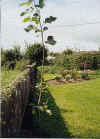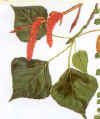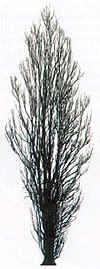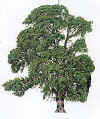Stop 15 on Trail 1 Spade-like shaped leaf
Poplar
is common name for any of about 35 species of trees in a genus of the willow
family. Poplars are short-lived, fast-growing trees native mostly to the
northern hemisphere.There are several kinds of poplars. Below is
information on two of the more common poplars, The Black Italian Poplar and The
Lombardy Poplar. They have different shapes but both grow to be very tall
trees. The leaves of many kinds of poplars are shaped like the symbol for
spades in a pack of cards.
The third poplar featured is a new breed which we planted. The soft wood of
poplars is used for paper pulp, in light construction, and in crate making.
Hooverst poplar
We
planted three poplar near the wall with the adjoining field to give shelter to
our shrub bed. This is a new breed of poplar tree which has been developed
in the last ten years and released commercially just recently. This is a
very fast growing timber and can grow three metres a year. It will grow to
120 cms in thickness in 18 to 20 years. This is very fast when you compare
it to the oak, for example which takes 300 years to maturity. The hooverst
grows well in wet ground. The Black Italian Poplar This tree is a hybrid (that is to say, a cross) between
the common European Black Poplar, which is the most massive of the poplars in
Britain, and an American black poplar called the Eastern Cottonwood. When full
grown the Black Italian Poplar has a long bole and heavy, slightly upcurved
branches, which have a tendency to bend away from the prevailing wind. The crown
is broad and fan-like and the catkins more fluffy than those of other poplars.
This is a very quick growing tree, and because of this it has often been planted
to form a quick screen to shelter something else from the wind. The Lombardy Poplar The Lombardy Poplar was introduced into Britain from
northern Italy in 1758. Because of its distinctive shape it is by far the best
known poplar in Britain. Indeed, for many people the word Lombardy poplar. This
is a tall and very quick growing tree; it will often reach a height of one
hundred feet in about thirty years. It is erect and narrow, and this is because
the branches do not spring away from the trunk (as is usual in most trees) but
stay close to it and follow the same upward direction. The timber has no
economic use, but, because this is one of the most ornamental of trees, it is
much used in landscape gardening.
We are grateful to one of our parents Mr. Philip Little who gave us the
poplars. We planted the trees in 1999.




